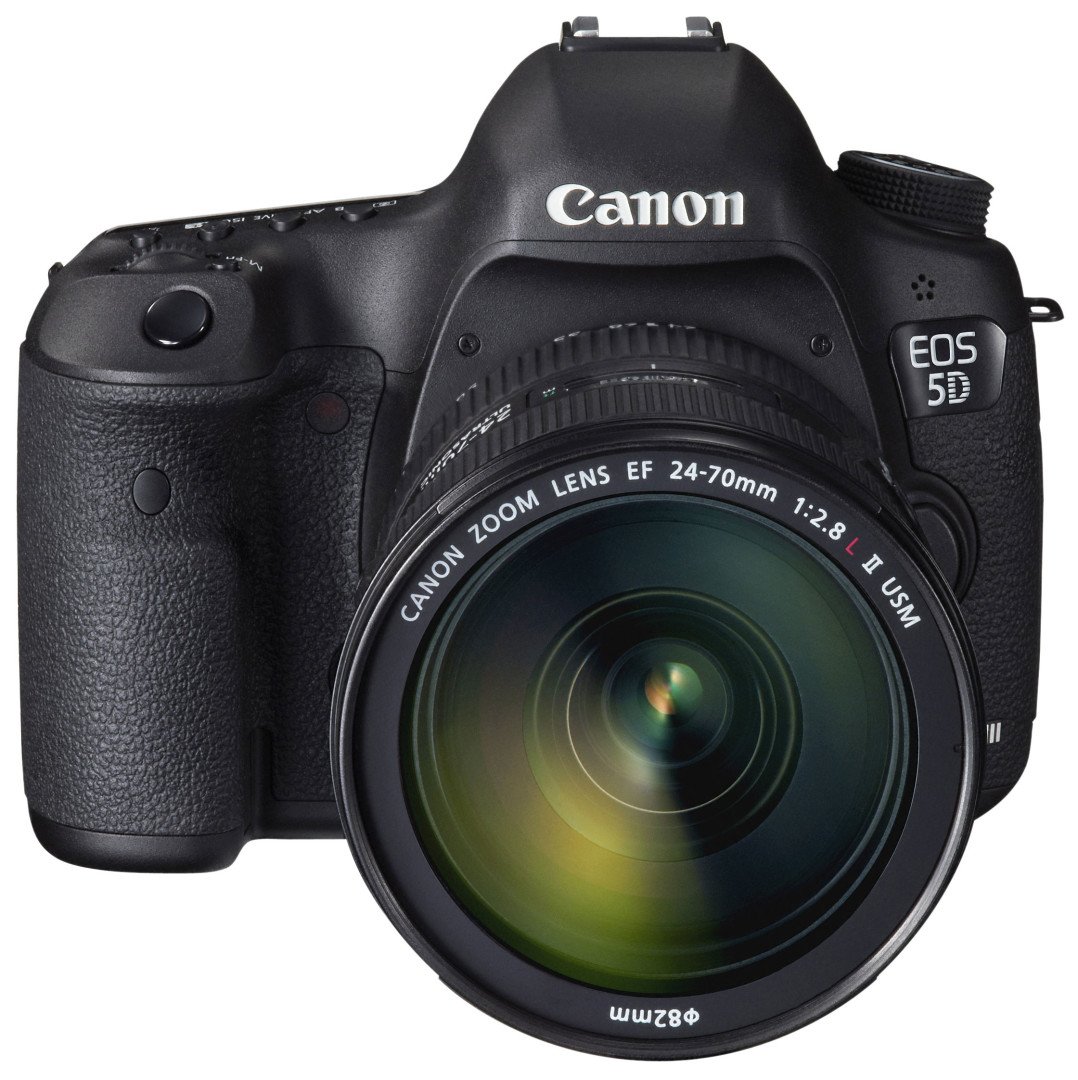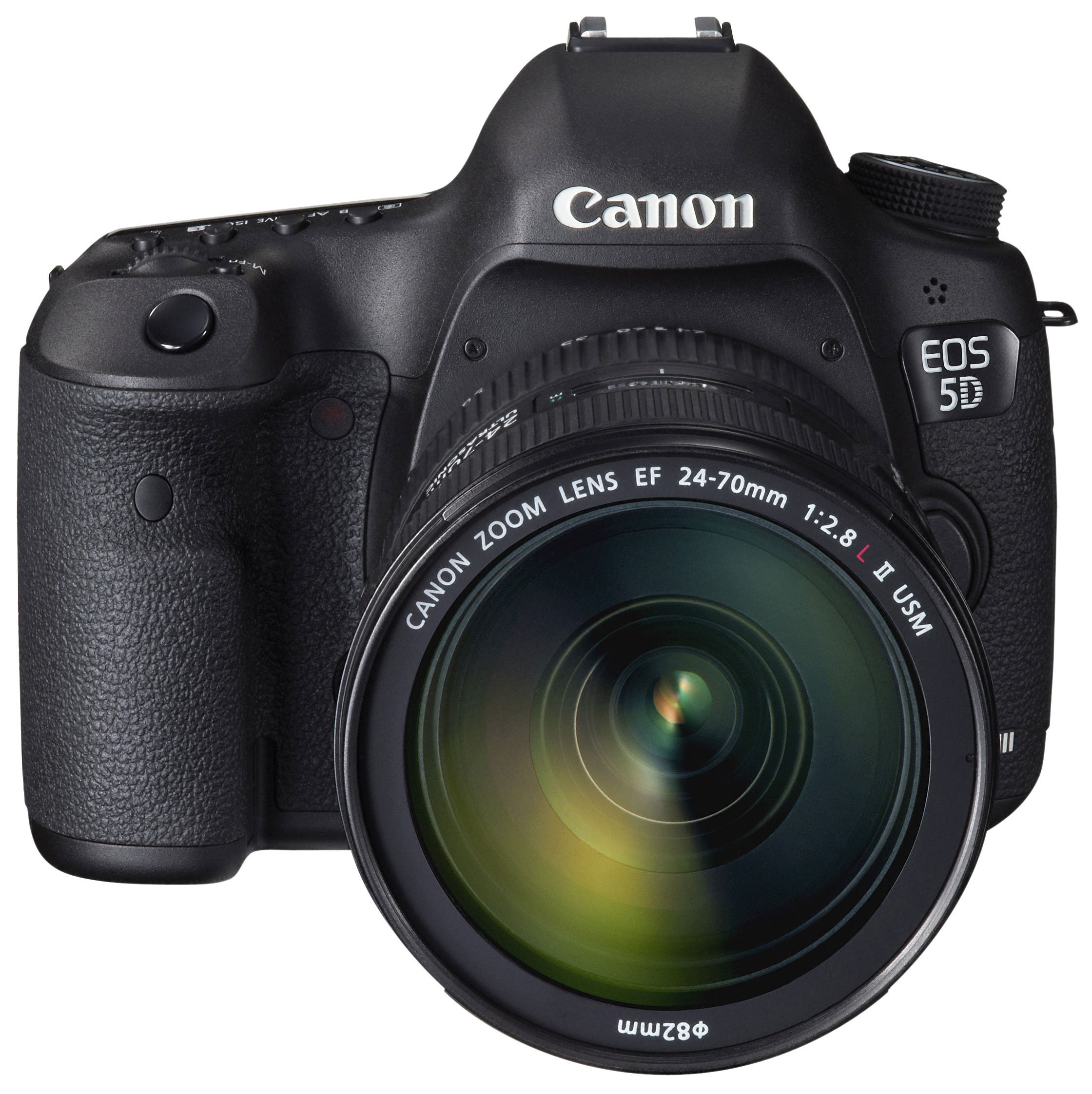
Canon EOS 5D Mark III
-
-
Written by Gordon Laing
Intro
The Canon EOS 5D Mark III is the successor to the enormously popular EOS 5D Mark II, and builds on the success of this full-frame DSLR. When the original EOS 5D was launched in October 2005, it represented the first ‘affordable’ full-frame DSLR. Three and a half years later, the Mark II almost doubled the resolution from 12 to 21 Megapixels and became the first DSLR to really embrace the potential of video recording, a feature which saw it adopted by most independent film makers, many TV productions and even larger studios wanting cheap B-cameras. Now three and a half years on from the Mark II in March 2012, we have the Mark III, arguably one of the most highly-anticipated DSLRs for years.
The headline specifications are a new 22.3 Megapixel full-frame sensor with 100-25600 ISO sensitivity (expandable to 102,400 ISO), 1080p video at 24, 25 or 30fps and 720p at 50 or 60fps, a 61-point AF system (with 41 cross-type sensors), 6fps continuous shooting, a viewfinder with 100% coverage, 3.2in screen with 1040k resolution, 63-zone iCFL metering, three, five or seven frame bracketing, a new three-frame HDR mode, microphone and headphone jacks and twin memory card slots, one for Compact Flash, the other for SD; the control layout has also been adjusted and the build slightly improved. So while the resolution and video specs remain similar to its predecessor, the continuous shooting speed, AF system, viewfinder, screen and build are all improved, and again there’s the bonus of twin card slots.
As is often the case, many of the enhancements have filtered down from other models. The 61-point AF system, headphone jack and 3.2in screen are inherited from the flagship EOS 1D X, while the metering along with much of the control layout and build come from the EOS 7D; meanwhile the 100% viewfinder is borrowed from both models. Indeed at first glance the 5D Mark III could be described as the love-child of the 5D Mark II and 7D with some parental input from the 1D X.
To be fair, this is what a lot of people wanted: the speed, AF, ergonomics, viewfinder coverage and increased toughness of the 7D but with a full-frame sensor. The 5D Mark III’s continuous shooting speed may not quite match the 7D, but 6fps is noticeably quicker than the 3.9fps of the Mark II, while the 61-point AF system far surpasses the 9 and 19-point systems of the Mark II and 7D respectively. It’s also nice to see Canon sufficiently influenced by Nikon to equip a non-pro body with twin memory card slots. In my full review I’ll delve into the new features and test-out the performance in practice, comparing it closely with its predecessor, the 5D Mark II, and its arch-rival, the Nikon D800. So if you’re thinking of buying a new full-frame DSLR, you’ve come to the right place!
(Many thanks to Queenstown Cameras in New Zealand for the loan of a 5D Mark III body for my initial tests, and Canon New Zealand for their continued support.)
Canon EOS 5D Mark III design and controls
Viewed from the front, the EOS 5D Mark III looks pretty similar to its predecessor, apart from a slightly different shaped head and the sensible relocation of the depth-of-field preview button to the grip side of the lens mount. Measuring 152x116x76mm it’s virtually the same width and depth as the Mark II, and only 2.5mm taller. At 950g for the body with battery, it’s only a little heavier than the 900g weight of the 5D Mark II.
Measuring 145x122x81mm, the Nikon D800 is 7mm narrower from the front, but 5mm taller and 5mm thicker, and a little heavier at 1000g including battery. Handle both bodies in person though and it’s fair to say their size and weight are roughly the same. Once a lens is mounted it’ll have a much greater influence on the overall size and weight.
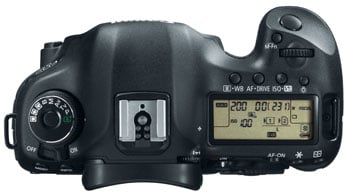 |
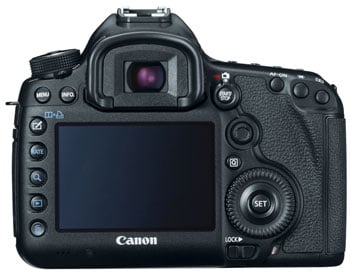 |
Canon describes the 5D Mark III as being tougher and better weather-proofed than the Mark II, but not to the same degree as the 1D series. This somewhat wishy-washy statement implies it’s similar in toughness to the 7D, so while you shouldn’t expect water-proofing, it is at least an improvement over the Mark II which proved surprisingly vulnerable at times.
But pick up the Mark III and its improved build and ergonomics over its predecessor become immediately apparent. It shares the EOS 7D’s solidity, lending it an air of greater confidence. The sculpted grip and more pronounced bulge on the rear for your thumb also provide a more comfortable and secure hold, while the rubber coating feels stickier – in a good way. Ergonomics are very much a personal thing, but in my view the Mark III represents a significant improvement over its predecessor in this regard; indeed it makes the Mark II feel quite basic in comparison.
In terms of build, I’d say it’s equivalent to the Nikon D800, and while I really like the hooked inner area of the Nikon DSLR grips for your fingertips, I personally felt the Mark III felt better in my hands overall due mostly to its more pronounced thumb rest. Again it’s a personal choice, but it’s great to see Canon really taking build and ergonomics as seriously as Nikon on non-pro models.
Like its predecessors there’s still no built-in flash, and this continues to be an aspect which differentiates Canon and Nikon’s ‘budget’ full-framers. The D800 does have a built-in popup flash which recharges quickly and is useful as a fill-in or controller, but the Mark III requires a separate Speedlite or transmitter. Canon would argue having a popup flash would compromise the build quality of the head and that typical 5D owners would demand something more powerful than a popup model anyway, but I still find a built-in flash very useful and its absence remains a disappointment on the Mark III.
The Mark III doesn’t have any built-in wireless capabilities either, although to be fair neither does the Nikon D800. So if you were holding out for built-in GPS and or Wifi, you’ll be disappointed. Both companies cite metal bodies along with global regulations over wireless channels as preventing them from integrating GPS or Wifi into bodies like the Mark III and D800, but it remains disappointing when (admittedly plastic) smartphones feature both. As it stands, GPS and Wifi capabilities are provided by optional accessories on both the Mark III and D800. For Wifi on the Mark III, you’ll need the WFT-E7A (costing a not inconsiderable $849 USD) while for GPS you’ll need the GP-E2. The Mark III alternatively supports much cheaper Eye-Fi SD cards, although Canon won’t guarantee their level of performance.
Moving onto power, the Mark III is powered by the same LP-E6 Lithium Ion pack as its predecessor, but Canon claims longer life of up to 950 shots under CIPA conditions compared to 850; clearly the new sensor and image processor are lower power consumers than their predecessors. For the record, the Nikon D800’s EN-EL15 battery should be good for up to 900 shots per charge.
The battery pack may be the same as the Mark II, but the Mark III demands a new optional battery grip: the BG-E11 can accommodate a pair of LP-E6 packs, six AAs or the optional AC adapter kit. It also duplicates a selection of controls for the portrait orientation, including the new multi-function button, more of which in a moment.
While the Mark III resembles the Mark II from the front, there are a number of differences on the top and a significant redesign on the rear. But first I’d like to mention the small, but considerate relocation of the depth-of-field preview button to the grip side of the lens mount, which means you can now press it with your third finger, while your index finger remains on the shutter release.
On the top you’ll notice the mode dial is lacking the Creative Auto mode of the Mark II but now features an enhanced Auto+ option along with a very welcome locking button in the middle. Like the EOS 7D, the chunky power switch is now found around the mode dial, another small but welcome improvement.
There’s still a detailed LCD information panel on the upper right side flanked by the same buttons as before, but there’s now a new customisable M-Fn button by the shutter release. This works similarly to the M-Fn button on the 7D and by default is used on the Mark III to switch between the various AF modes, more of which in the focusing section later.
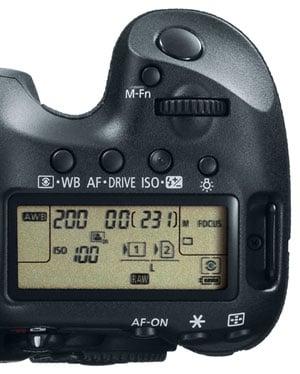 |
The upper information screen is packed with details including the aperture, shutter speed, ISO, white balance, AF mode, quality settings for each card, shots remaining, drive mode and exposure compensation scale between +/-3EV (although you can select +/-5EV via the main screen on the rear). In a first for a Canon DSLR of this class, the shots remaining aren’t truncated to 999, but a maximum of 1999. The Nikon D800 also features a detailed upper LCD screen, but strangely you still can’t see ISO and shots remaining at the same time. To be fair though the D800’s top screen also has to accommodate flash settings for its popup unit, and still shows the shots remaining even when powered-off – a classy touch Nikon owners have enjoyed from film SLR days.
A quick note on the shutter release: it’s the usual sprung soft-touch (ie, no click) release as found on previous 5D generations, but it feels a lot more sensitive. It requires a much lighter pressure to trigger the shutter than before, which can catch you out if you’re used to earlier Canon DSLRs – indeed for your first few hours with the Mark III, you’ll almost certainly be mistakenly taking pictures when you only meant to half-press the shutter. But before long you get used to the required pressure and what started as a surprise becomes a non-issue.
Most of the Mark III’s exterior changes take place on the rear, where it’s heavily influenced by the EOS 7D. So along with the new chunky power switch in the upper left corner, the Mark III gains the 7D’s useful Live View / Movie switch and button to the right of the viewfinder window. It also gets a new Q button near the joystick, a new Rate button to score images (from one to five stars), and a new magnify button which works in conjunction with the wheel to zoom in and out; the labelling is also now on the buttons rather than under them. If you’re used to earlier Canon DSLRs, you may find the change in magnification control a little unsettling at first as your thumbs will naturally head to the top right corner controls. But before long, the relocation feels natural and keeps the AF area and AE lock buttons as clean single-purpose controls.
You can’t tell from the photos, but the Mark III also inherits the neat touch-sensitive control of the 1D X which allows silent adjustments in the movie mode. Once enabled, you can tap up, down, left or right on the inside edge of the rear wheel to make adjustments, and I’ll discuss this in greater detail in the movie mode section.
In terms of connectivity, the Mark III shares the same ports as its predecessor (PC Sync, Mini HDMI, USB-2, Video, E3-remote and stereo microphone), but adds a new headphone jack for monitoring audio when filming movies – a very welcome addition, see later. Note Nikon’s D800 also sports microphone and headphone jacks, but its USB port exploits the speed of USB-3 and its HDMI port can deliver a clean signal to external recorders.
In another welcome move, Canon has equipped the Mark III with twin memory card slots, one for Compact Flash as before, and a second for SD cards, bringing it in line with the D800, and like that model you can configure the slots to record different image formats simultaneously if desired. The Mark III will exploit the speed of UDMA-7 CF cards, but disappointingly it won’t exploit the speed of UHS-1 SD cards. Canon is quick to point out it’ll still work with UHS-1 cards and of course a compatible card reader will be able to copy images from it quicker onto your computer, but it still feels like a strange omission on a new camera of its class. Revealingly the Nikon D800 supports the extra speed of both UDMA CF and UHS-1 SD cards. I’ll let you know if it makes any difference in my continuous shooting section later in the review. Even if the Mark III won’t exploit the fastest SD cards though, it’s still nice to have support for the format as SD cards are typically cheaper than CF at the same capacity – it also gives the Mark III a more affordable Wifi option in the form of Eye-Fi SD cards.
Canon EOS 5D Mark III viewfinder
The EOS 5D Mark III receives an important upgrade to its viewfinder, which now enjoys full 100% coverage compared to 98% on the Mark II, and usefully offers similar on-demand LCD guides and AF-point indicators as the 7D. Thank goodness the removable focusing screens are now finally put to rest.
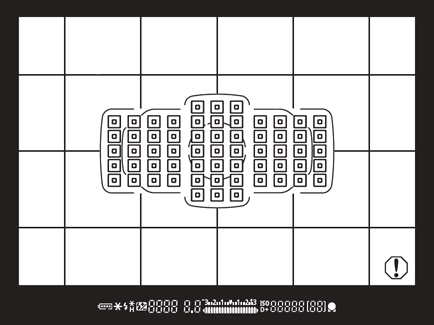 |
Hold both the Mark II and Mark III to your eye and you’ll notice the view from the latter is a little larger, but more importantly, more accurate thanks to its 100% coverage. Now there’s no surprises when you’re framing with the viewfinder on the Mark III as what you see really is what you’ll get. It’s also nice to see the complete imaging circle from lenses like the EF 8-15mm Fisheye Zoom through the viewfinder, when previously it was cropped a little at the top and bottom. Of course the final image always had 100% coverage, but it’s nice to finally confirm it through the viewfinder too.
In this respect, the Mark III is identical to the Nikon D800, and switching between both bodies reveals they share essentially the same viewfinder coverage and magnification – in short, big, bright, beautiful and a joy to compose with.
The 5D Mark III also becomes Canon’s third DSLR, after the 7D and 1D X, to feature on-demand LCD graphics in the viewfinder. These replace the interchangeable focusing screens of earlier models and I much prefer this approach as the options are much richer and more dynamic, not to mention eliminating the need for an optional and fiddly accessory; you can also simply turn them off for a completely clean view. To be fair, Nikon has implemented on-demand LCD viewfinder graphics for many years now, but it’s still nice to see Canon gradually deploying them across more models.
The 5D Mark III can switch an alignment grid on or off, along with displaying any number of its 61 AF points with outlines indicating their coverage in certain modes or with certain lenses. Meanwhile a faint dotted circle indicates the spot-metering area. If the VF electronic level option is enabled, the AF markers can also act as a dual-axis levelling gauge.
The D800’s viewfinder graphics are superficially similar, again with an optional grid and little rectangles indicating each of the 51 AF points along with outlines for their coverage on the frame. Where the D800’s viewfinder graphics differ though are lines marking the optional crop modes (such as 5:4 and DX format), and a pair of scales along the bottom and right side which provide virtual horizon facilities.
Running along the bottom of both viewfinders is a wealth of information including the aperture, shutter, ISO and remaining shots at all times, along with an exposure compensation scale and focus indicator. The Nikon D800 also displays the metering mode, while the Mark III shows battery life.
One final point, the D800, like earlier high-end Nikon DSLRs, features a small lever by the viewfinder which closes a built-in blind to prevent stray light from entering, whereas the Canon requires you to clip a cover over. It’s a classy touch on the D800.
Canon EOS 5D Mark III screen
The EOS 5D Mark III enjoys an upgraded screen inherited from the EOS 1D X. It’s bigger than the Mark II at 3.2 vs 3in, more detailed with 1040k vs 920k dots, and perhaps most importantly of all, wider with a 3:2 shape vs 4:3.
 |
These numbers may not sound significantly different from the Mark II, but don’t be fooled. The Mark III’s 3:2 shaped screen means images now fill it as oppose to being displayed (or framed in Live View) with a thick black bar below them. This means the displayed image is larger than before and also exploits all of the available pixels for a more detailed image. The benefit of a wider shape was clear on the 3in 3:2 screens of models like the T3i / 600D, but it’s even better here at 3.2in.
16:9 video is still shown with letterboxed bars above and below, but again now occupies a larger percentage of the screen than before for a bigger and more detailed view, which is not only nice to look at but easier to focus.
Meanwhile, Nikon’s D800 also enjoys a new 3.2in screen, but like all Nikon DSLRs to date it remains 4:3 in shape and also has the same 920k pixels as its predecessor. As such images in the native 3:2 FX or DX formats are displayed with a thick black bar below them in playback and live view. This means they measure 3in on their diagonal as oppose to 3.2in on the Mark III, and also measure 640×426 pixels as oppose to 720×480 pixels. These numbers may seem minor, but believe me when both cameras are side by side, the displayed images from the Mark III are a little larger and more detailed, and it certainly allowed me to confirm Live View or Movie focus more easily without magnification.
Overall the larger, wider and more detailed screen of the Mark III is a really nice upgrade – not to mention superior to that on the D800 – but I can’t be the only one who’s disappointed not to find the articulated mounting of the T3i / 600D and 60D here. I know there’s subsequent compromises in ultimate toughness, but I know videographers, not to mention Live View shooters would greatly value the facility. I assume this will be one of the differences between the Mark III and the proposed video concept DSLR teased in 2011.
Canon EOS 5D Mark III Live View
The EOS 5D Mark III shares similar Live View facilities to the EOS 7D, and as such represents a significant upgrade over the Mark II in operation.
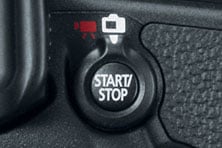 |
Unlike the Mark II which featured a button to the left of its viewfinder to enter Live View, the Mark III now features a small dial to the right with a Start / Stop button in the middle. With the dial pointing upwards at the Live View icon, just press the Start / Stop button to enter Live View and again to exit. And unlike the older model, there’s no need to enable Live View first from a menu – it’s already enabled by default.
Like other recent models, the Mark III also lets you autofocus in Live View by simply half-pressing the shutter release. This is much more intuitive than pressing the AF-ON button on the back, although you can still do this if you prefer. These changes of enabling Live View by default, providing an obvious control for entering and exiting the mode, and auto-focusing with the shutter release may be simple modifications, but they greatly improve the overall user experience.
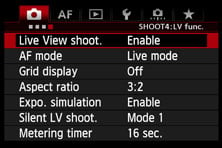 | 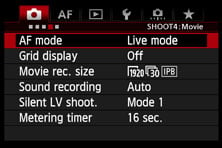 |
The small dial’s second position switches the Mark III straight into its Movie Mode, after which the Start / Stop button begins and ends filming. With the Mark III set to Movie Mode, you’ll also notice some changes to the first set of menus to include movie-related options. So if you were wondering where the video quality settings were, you’ll need to enter Movie Mode first. Again this is much more intuitive than having pages of often confusing options for both Live View and Movies as found on the EOS 5D Mark II. A big improvement all round.
Once Live View is active, the presentation and options are essentially the same as the EOS 7DI, with a few minor changes. Live View on the Mark III offers 100% coverage and exploits the full resolution of the screen, with a smooth refresh. The effect of different apertures can be previewed by pressing the depth-of-field preview button. The camera will temporarily increase the screen brightness to maintain a consistent image; this may result in greater on-screen noise, but it won’t appear in the final image.
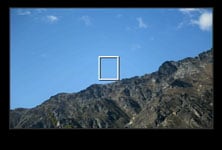 | 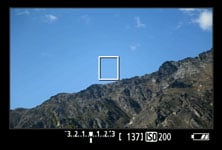 | 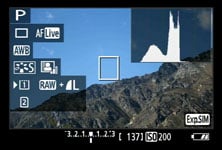 |
Pressing the Info button cycles between a clean view, one with shooting information running beneath the frame and a third view which superimposes additional information over the image. If Exposure simulation is enabled in the Live View menu, a Live Histogram is added to the frame, which looks very detailed thanks to the display resolution.
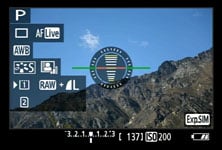 | 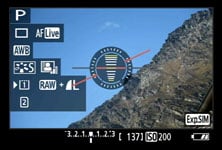 |
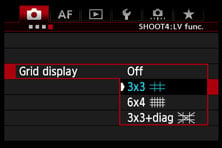 | 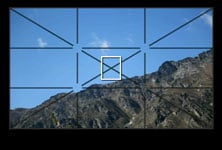 |
An additional page view super-imposes a small dual-axis levelling gauge in the middle of the screen. The gauge is also available outside of Live View, again by pressing the Info button – see Menus section below. Note the D800 also offers a dual-axis levelling gauge in Live View.
There’s also the option to superimpose one of three alignment grids on-screen, although these are still enabled from the Live View menu, when it would surely be quicker and more intuitive to have them appear while pressing the Info button. The Nikon D800 toggles its grid in Live View using the Info button which is much easier, and hallelujah, it finally breaks Nikon’s tradition of not including a live histogram on a non-pro body – in short, a live histogram is available on the D800.
Like the Mark II before it, the Mark III offers the choice of three AF modes in Live View, although they’ve had a minor reshuffle: the default option is now Live Mode which employs a silent and uninterrupted contrast-based system. The second option sticks with contrast-based focusing, but adds face detection. Finally, the Quick Mode flips the mirror down to take a reading from the traditional 61-point phase-change AF system. Once again I’m pleased to report an intuitive half-press of the shutter release can be used to trigger the autofocus in any mode, although pressing the AF-ON button on the rear has the same effect if preferred.
With the Mark III set to Live mode, you’ll see a single large white frame which can be moved around the screen using the joystick. Half-press the shutter release and the Mark III will focus on whatever’s in the frame. At best this will take just under two seconds before the frame turns green with a double-beep to confirm, but with trickier subjects the process can take closer to four seconds. There isn’t any interruption to the display though, nor the sound of the mirror flipping.
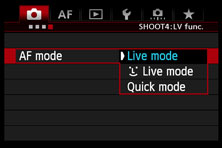 | 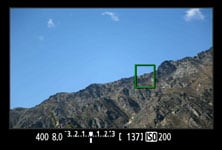 | 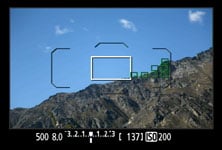 |
The Live mode with face detection (indicated by a smiley icon) uses the same contrast-based system as normal Live Mode, but if it recognises a human face, it’ll frame it with a box and focus on that when you half-press the shutter release; if there’s more than one face in the scene, you can use the joystick to select the one to focus on. As you might expect, the Mark III has no problem tracking faces around the frame, but the actual focusing process itself can still be slow, and if the face isn’t already sufficiently sharp to start with, the system won’t even recognise it. If you’re lucky, the camera will lock on and confirm within a couple of seconds, but if it ends up being longer, it’s easier to exit Live View and frame portraits through the viewfinder instead.
In Quick mode you’ll see a graphical representation of the active AF points on-screen. Half-press the shutter release and the mirror briefly flips down to take a reading, indicates the active AF points in green with a double beep if sounds are enabled, then flips back up again to continue the view. There’s obviously some noise and an interruption to the image, but it remains the quickest of the three AF modes in Live View – indeed, if the AF system locks onto the subject without a problem, the entire process can take less than a second.
At any time during the Quick or Live AF modes, you can press the new magnify button to show a 5x view, then a 10x view. The Mark III will zoom-in on wherever the white frame is positioned on screen, which can be moved before or during using the joystick.
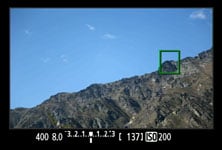 | 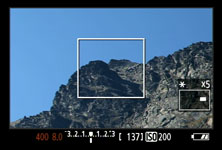 | 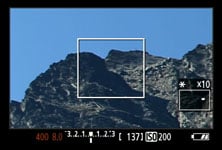 |
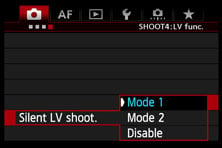 |
The Mark III also inherits the silent shooting options of its predecessor. Mode 1, the default, is quieter than normal shooting and also supports continuous shooting at around 6fps, although you’ll be shooting blind with both the screen and viewfinder blanking out while you keep the shutter release pressed.
Mode 2 is quieter still by employing an electronic first curtain shutter to actually take the picture, but delaying the noisier re-cocking of the physical shutter so long as you keep the shutter release held. The idea is to press the shutter release button to take the photo (with a very faint click), but keep it held until you’re out of ear shot, after which you can let go, allowing the Mark III to audibly re-cock the physical shutter. You may only be able to take one photo with this technique, but it could be useful in certain situations.
Note there’s also an option to disable Silent Shooting altogether, which sounds like the camera’s taken two shots; Canon only recommends using this to avoid exposure issues with extension tubes or Tilt and Shift lenses.
Finally, Live View on the Mark IIIis also available at a higher resolution when the camera’s connected to an HDTV using the HDMI port, or connected to a PC or Mac and using the supplied EOS Utility. Note, the image seen on the live HDMI output will reduce in resolution if you start filming video in the HD mode, although to a lesser extent than the Mark II and again it won’t affect the quality of the recording.
Canon EOS 5D Mark III shooting information and menus
Like the Mark II before it, the Mark III can show a wealth of shooting information on its main colour monitor. To view any shooting information, you’ll need to press the Info button, which cycles through up to three pages of details before then switching the screen back off again; there’s no eye sensors below the viewfinder to automatically switch the screen off. Like the 7D you can view shooting settings, camera settings or an electronic two-axis levelling gauge, as seen below.
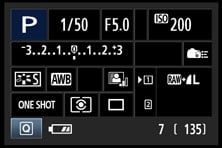 | 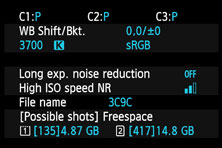 | 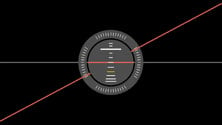 |
The main Shooting Settings page shows all the really important stuff like the aperture, shutter, sensitivity, exposure compensation, and works with Canon’s Quick menu system which allows you to highlight and adjust many of the settings on-screen. This works similarly to the Mark II, although Canon’s managed to squeeze in a couple more options here.
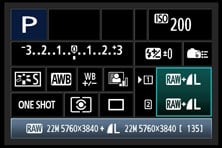 | 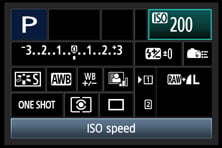 |
In the bottom left corner of the screen you’ll see a letter Q, representing the Quick Control system, although unlike its predecessor, you now activate it by pressing the new Q button. You can then move a blue / green highlighter over the desired setting using the joystick and then either turn the thumb wheel or finger dial to directly adjust it, or press the SET button to view a dedicated menu for that item. These dedicated menus also appear when you press the Metering / WB, AF / Drive or ISO / flash compensation buttons alongside the upper screen.
It’s similar in practice to other on-screen adjustment systems like those pioneered on Olympus and Sony DSLRs, and offers quick access to numerous settings. Unfortunately Canon’s still resisted the temptation to rotate the characters to remain upright when shooting in the portrait orientation though.
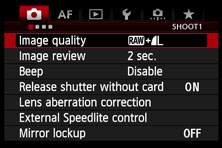 | 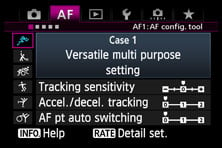 | 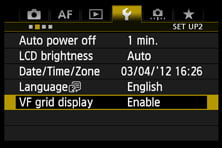 |
Pressing the Menu button enters the main menu system which has been revamped with a dedicated tab housing five pages just for AF alone – see below for details. The page transitions have also been enhanced. As before you can exclusively use the joystick for navigation, or use the finger dial to switch pages and the thumb wheel to scroll through the options on each.
In playback mode, pressing the Info button cycles between a clean image, one overlaid with a little shooting information, then a thumbnail with extended shooting information and a brightness histogram, and finally a thumbnail with less shooting information, but both brightness and RGB histograms. The page with just the brightness histogram and extended shooting information can be switched to display RGB histograms instead if preferred. New to the Mark III is the ability to give an image a star rating from one to five using the new RATE button.
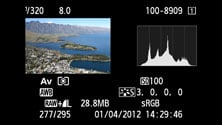 | 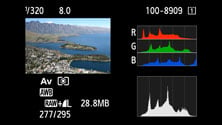 | 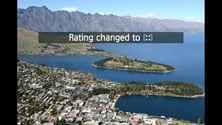 |
You can of course magnify the image for a closer look, although as explained above, this is now done using the new magnify button in conjunction with the finger dial – this change of control will have owners of earlier Canon DSLRs scratching their heads for a while. It’s also possible to develop RAW files in-camera with a broad selection of parameters to adjust.
Canon EOS 5D Mark III Autofocus
In arguably the biggest upgrade over its predecessor, the Mark III inherits the same 61-point AF system as the EOS 1D X – a significant boost over the earlier 9-point system. And like the 1D X, it’s not just about playing a numbers game on total points either, as a considerable 41 of them are cross-type sensors, while five boast dual cross-points.
It also represents an important milestone for Canon which has traditionally been out-numbered by Nikon on AF specifications in most DSLR categories. The D800 also inherits the AF system of a higher-end full-frame pro body, in this case the D4, but in terms of numbers these feature 51 points, 15 of which are cross-type sensors. It’s a nice numerical win for Canon, but as always these are just the specifications and it’s important to put them through their paces.
The Mark III’s AF system is highly configurable across no fewer than five new dedicated menu pages; indeed Canon has produced a 47 page guide (for the 1D X which also applies to the Mark III) just to explain all the features. This guide and the Mark III manual also explain which lenses can exploit which AF points in the system, as the most sensitive dual-cross type sensors in the middle only work with lenses at f2.8 or faster, while others are limited to f4 or faster. But even in the worse-case scenario with ageing, slow or obscure lenses you’ll still have 33 AF points / 15 cross-type sensors to work with.
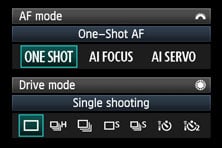 | 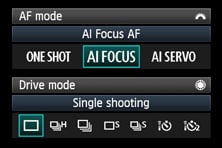 | 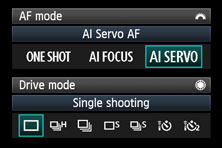 |
The AF system is broken down into three main aspects: first is the actual AF mode, from which you have the usual One Shot, AI Focus and AI Servo options, second is the choice of the AF point or grouping, and third is an expanded set of options to describe the motion and therefore the tracking.
The choice of AF point will be familiar to anyone who’s used the EOS 7D. You can choose from Single Point or Single Point Spot (the latter being a smaller area), AF Point Expansion (which also takes four points above, below, left and right into consideration), AF Point Expansion (which also takes eight points around the manually selected area into account), Zone AF (which divides the full area into nine smaller groups of AF points), and finally 61-point Automatic Selection. To switch between these modes, simply press the AF area button on the back of the camera, then use the M-Fn button by the shutter release to cycle through them. In the case of the manual point selection you can either use the rear joystick or a combination of the finger dial and thumb wheel to make your choice.
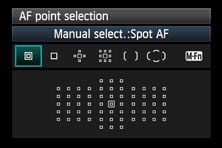 | 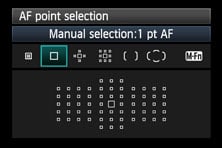 | 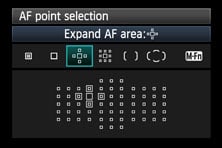 |
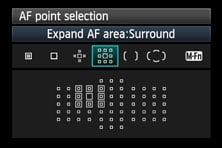 | 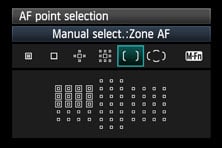 | 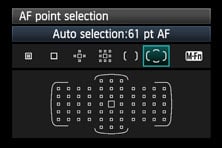 |
So far so similar to what’s come before, but what makes the Mark III and 1D X stand out is the third set of options which let you describe the motion of the subject for more successful tracking. Canon offers three parameters to describe the motion: Tracking Sensitivity, Acceleration / Deceleration Tracking and AF point Auto Switching. While some of these have been seen in Custom functions of on earlier models and can still be manually tweaked, Canon now provides six ‘Case’ presets for specific styles of sports and with the Summer Olympics surely in mind, uses immediately recognisable icons to identify each. It’s almost like the graphics of TV coverage.
 | 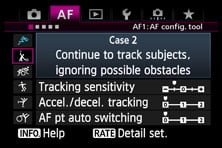 | 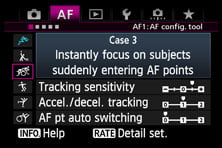 |
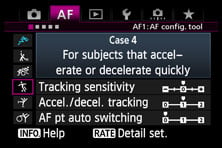 | 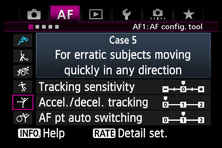 | 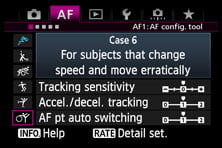 |
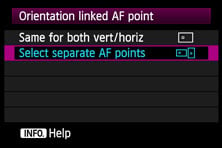 |
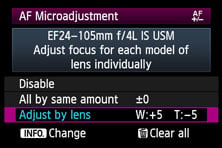 |
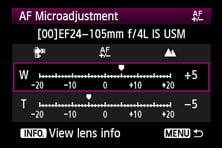 |
Case 1 is a general-purpose tracking option for predictable motion – think of it as the standard option. Case 2 attempts to track the subject while ignoring obstacles and is described as being ideal for tennis, butterfly swimmers and skiers. Case 3 instantly focuses on subjects suddenly appearing over AF points and could be useful for the start of bike races or during alpine skiing, skateboarding or freestyle events where a subject could quickly move into the frame. Case 4 is for subjects which accelerate or decelerate quickly, such as football, basketball or motor sports. Case 5 is designed for erratic motion moving quickly in any direction like figure skaters, while Case 6 covers subjects which change speed and move erratically, like rhythm gymnastics.
I’m no sports photographer so I’ll leave detailed analysis of the different cases to those who do it for a living. I do hope to include some comments from some pro sports photographers in the near future though. I did however explore the different AF point and zoning options for shooting a variety of subjects in motion including mountain biking, jet-boating, cars and kids running around.
Like the 7D before it, I enjoyed a high degree of success with the various expansion options which concentrate on a single manually-selected AF point, but also consider those immediately around it providing a bit of breathing space. These proved very useful for tracking kids running around the frame. I also found the spot AF useful for precisely targeting a subject, such as a person’s eye when they’re wearing a hat or helmet with a wide brim. Meanwhile the zone AF was a handy way of just leaving the camera to work out everything, but giving it the guidance that the subject was in a specific section of the frame.
I also appreciated the option for Orientation Linked AF Points, where the point, area or zone could automatically adjust depending on portrait or landscape shooting. So if you’d preset the area to the top left in the landscape orientation, it could automatically reposition itself to the top left when turned to portrait. This sounds a bit obscure when written-down, but in practice I used it frequently.
In each situation I put it into the Mark III returned a high ratio of hits and felt responsive and very confident. It really feels a world-apart from its predecessor. As for its big rival, the D800, it too performed very well in my AF tests and also enjoys the benefit of supporting AF on lenses with apertures between f5.6 and f8, albeit with a reduced number of points. Once both cameras have been literally out in the field for some time with pro sports photographers, I’ll come back with further reports and analysis.
Just before wrapping-up this section I’ll mention a useful update to the AF Micro-Adjustment options, which now let you enter different values for both ends of a zoom range rather than just one.
Canon EOS 5D Mark III metering and exposures
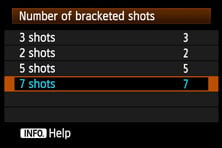 | 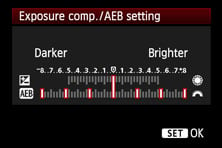 |
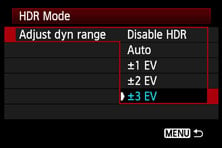 | 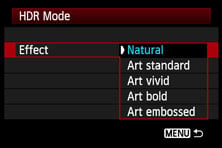 |
The EOS 5D Mark III inherits the 63-zone iCFL metering system of the EOS 7D and the latest lower-end models. It may not come anywhere near the sophistication of the 100,000 pixel metering sensor of the EOS 1D X, but it remains an improvement over the ageing 35-zone TTL metering of the Mark II. The Mark III also shares the Partial, Centre-weighted and Spot metering options of the Mark II, but the Partial and Spot sizes have reduced from 8 to 6.2% and 3.5 to 1.5% respectively.
Shutter speeds remain between 1/8000 and 30 seconds with a Bulb option and a fastest flash-sync speed of 1/200, and the shutter block is still rated to 150,000 actuations; note Canon claims the block has been improved, but as I recall, the Mark II was rated to 150k too. Note Nikon’s D800 boasts a flash sync speed of 1/250 and a shutter block rated to 200,000 shots.
However in a surprise and very welcome move, Canon has finally equipped a non-1D series camera with decent exposure bracketing, so it’s out with the (frankly insulting) three-frame options of earlier models and in with three, five and seven frame exposure bracketing. This may still not match the nine-frame bracketing of the D800, but it’s still an important upgrade which will have HDR fanatics rejoicing. And speaking of HDR, there’s also a new HDR mode which captures and combines three frames (at 1, 2 or 3EV increments) using a choice of five tone-mapped presets, while also considerately recording each frame separately in case you prefer to do your own processing later. Here’s an example comparing a single exposure shot against a 3EV HDR using the Natural tone-mapping.
Canon EOS 5D Mark III Aperture Priority mode | Canon EOS 5D Mark III High Dynamic Range (3EV / Natural tone mapping) | |
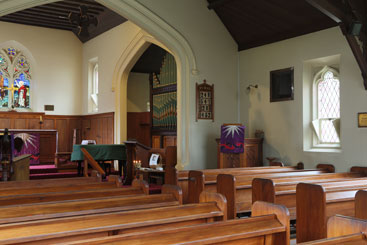 | 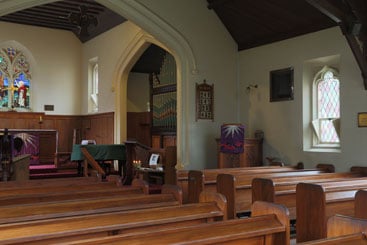 | |
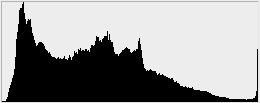 | 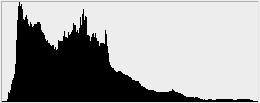 | |
2 secs, f8, 100 ISO | 1.3, 1/6 and 10 secs, f8, 100 ISO | |
The Mark III also inherits the multiple exposure capabilities first seen on the 1D X, allowing it to combine up to nine separate frames into one, using a choice of four compositing options: Additive, Average, Bright and Dark. I’m really pleased to find Canon finally offering deep bracketing and multiple exposure capabilities on this line. What the Mark III doesn’t have though is any kind of built-in time-lapse or interval shooting facilities, both of which are built-into the D800.
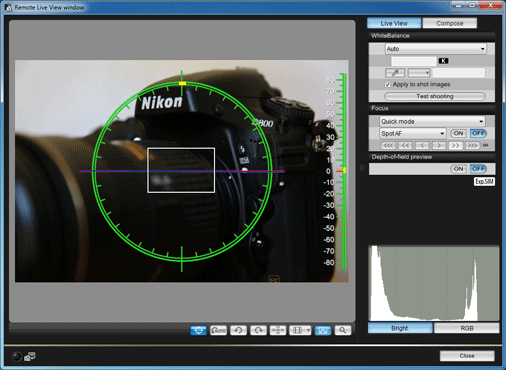 | |
In terms of shooting modes, the Mark III has the same PASM, Bulb and three Custom options as before, but the frankly out of place Creative Auto mode has now been removed and the Green Square Auto now upgraded to Auto+. The Auto+ mode may not feature the same degree of scene detection as the EOS 1D X due to its less sophisticated metering system, but it’s still a step-up over the 5D Mark II. Incidentally the Nikon D800 remains ‘purer’ with just PASM modes and no dedicated fully Auto option; of course Program is essentially Auto, but it’s interesting to see the different approaches of Canon and Nikon in this regard.
Like all EOS DSLRs, the 5D Mark III is also supplied with the free EOS Utility, which supports full remote control of the camera using a PC or Mac, although I’m disappointed not to find it natively running on iOS or Android devices yet. To be fair you could fit the Wifi transmitter and remote-control the camera via a web interface on any device with a browser (including tablets and smartphones), but I’d still prefer a native application, ideally with a direct connection.
The EOS Utility looks much the same as before, but now lets you set HDR options remotely and refers to broader Lens Aberration Corrections as oppose to just Peripheral Illumination Correction. In Live View Shooting you can also superimpose virtual levelling graphics in two axes along with loading an optional ‘overlay image’ for lining-up the composition.
Canon EOS 5D Mark III Movie Mode
Nikon’s D90 may have been the first DSLR to offer video recording, but it was the EOS 5D Mark II which made it truly useful to professionals. It’s fair to say the enormous popularity of the Mark II for video came as a surprise to Canon, but the company really took the ball and ran with it, refining the features in subsequent models and updating the original with enhancements.
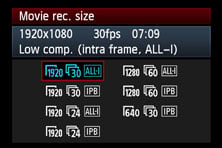 |
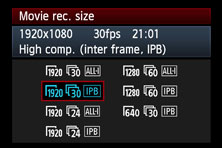 |
 |
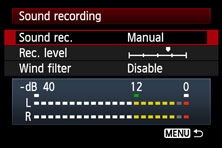 |
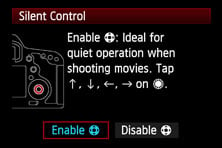 |
As such it’d be fair to expect some big improvements on the Mark III for video, but the headline specs remain very similar to what we’ve had before. So you still get 1080p at 24, 25 or 30fps, but sadly no 50 or 60fps options at this resolution. Offering some consolation is the final addition of 720p at 50 or 60fps, but given this has been offered by entry-level Rebels for some years, forgive me if I’m not that excited. I realise there’s codec and data issues, but when Sony and Panasonic are widely deploying 1080p at 50 and 60fps, it’s a shame not to see it on the 5D Mark III. Why do I want it? For slow motion. Film at 60fps and you get a two or 2.5 times speed reduction in 30 or 24fps projects without losing smooth motion. The Mark III will let you film at 50 or 60fps, but only by reducing the resolution to 720p.
But beyond the frame rates, there are some important enhancements. First is the choice of intra-frame (ALL-i) or inter-frame (IPB) compression formats inherited from the 1D X, the former capturing higher quality and more easily editable footage, albeit at a hungrier data rate. The Mark III also inherits the 1D X’s SMTPE timecode embedding, allowing easier syncing in post production.
Like the 1D X, the Mark III can also record clips one second shy of half an hour thanks to files which seamlessly run into each other – a big boost over the 12 minutes or so of the Mark II and making it a lot more useful for interviews. In my tests the IPB 1080p footage consumed about 240MB per minute and ALL-i 1080p footage about 650MB per minute.
As mentioned earlier, another important addition is a headphone jack, which allows you to monitor audio. You can also set the audio levels manually before or during filming, with live stereo meters as a guide.
What really makes this useful though is the inclusion of ‘silent’ controls, inherited from the 1D X. Previously to adjust the aperture, shutter or ISO while filming, you’d need to spin one of the control dials, which resulted in audible clicks. While it is possible adjust these settings along with audio levels on the Mark III using the dials, you can now alternatively enable ‘Silent Control’. At first this doesn’t appear to do anything as the silent control option only becomes live once you start filming.
Start rolling and after cycling the Q button you’ll see the usual shutter, aperture, ISO and audio level values. The big difference now though is the inside circle of the rear wheel becomes touch-sensitive. Tapping up and down allows you to highlight the shutter, aperture, ISO or audio values, after which tapping left and right will change the setting.
In use this can work really well. Tap too hard and you will of course hear the noise, but small and gentle taps will work just as well without making a sound. Unfortunately the electronic aperture control in most EF lenses still makes a loud chunk sound when changing, which lessens the usefulness of silent control for that particular setting, but for the shutter, ISO and audio levels it really is silent and works a treat – it’s a valuable enhancement to the Mark III.
What you still don’t get though is a clean output over HDMI to feed an external recorder. During composition you always have the white focusing frame as a minimum, and once recording, there’s the ever-present red circle in the upper right corner – and in both instances, the image itself is framed with thick black borders, so the active area actually measures 1620×910 pixels. To be fair, the new intra-frame ALL-i compression option does reduce the need or desire for an external recorder, but some film makers would still have preferred the flexibility of a clean HDMI output either way. As for those using external monitors, the active image area of 1620×910 pixels over HDMI when recording will at least deliver a more detailed image than the earlier Mark II, making focus-pulling easier.
At this point I should note the Nikon D800 does offer a clean HDMI output which can feed an external recorder. So while the D800 misses out on the low compression intra-frame (ALL-i) option of the Mark III, you could record the HDMI output with an external device at a higher bit rate if desired. The D800 also has its own version of silent movie control too with a pair of buttons between the lens mount and grip which can be operated by your middle and third fingers to adjust the aperture if desired. In a somewhat perverse decision though you can only use these buttons to control the aperture before you start recording, so if you’d like to use them while filming, you’ll need to use an external recorder.
Now back to the Mark III. In a rather sad decision, Canon’s chosen not to implement any kind of movie crop mode to deliver a magnified image. This is a real shame since the Mark III’s sensor resolution was specifically chosen because it could squeeze exactly three 1920 pixel wide frames side-by-side, so it could have allowed a 1:1 crop with an effective magnification of 3x for 1080p video without loss of resolution. This would have been fantastic for filming small or distant subjects – I certainly enjoyed using the EOS T3i / 600D’s movie crop mode for filming the Moon, but a similar option is not available here. Note the D800 may be lacking the 1:1 crop option of the D4, but it does offer a DX (1.5x) crop for video, so in that respect enjoys an advantage over the Mark III. I should however note that the D800’s down-sampling / pixel-binning for video results in a minor crop of the filed-of-view when filming in the full-frame format, whereas the Mark III does not. When filming with the Mark III, you’ll enjoy exactly the same horizontal coverage as for still photos.
If you’re at the consumer-end of the movie-making world, you won’t be enjoying continuous auto-focusing while filming with the Mark III either. This remains an elusive goal for a traditional DSLR. Nikon may have its Full time AF mode, but it’s a ‘solution’ you’ll want to disable immediately. As such the 5D Mark III and D800 essentially remain manual focus only for video once you start rolling. Both can perform a single refocus while filming, but it’ll take a couple of seconds, so isn’t ideal unless you can edit it out later. If you want continuous AF while filming, you should consider a mirrorless CSC or one of Sony’s SLT models.
The earlier Mark II also suffered from a number of undesirable video artefacts including moire and rolling shutter / jello effects. Canon claims to have reduced both on the Mark III along with lowering the noise levels, so now let’s put all the theory into practice and take a look at some video comparisons.
Canon EOS 5D Mark III vs Mark II Movie samples
In my first test I took the EOS 5D Mark III and the earlier 5D Mark II into a dim bar environment and filmed the same slow panning sequence three times each, at 3200, 6400 and 12800 ISO. Each camera was fitted with the same EF 50mm f1.2L lens, focused on the same point. The movie mode was set to 1080/30p with the Mark III set to IPB compression. The shutter speed on both cameras was manually set to 1/30 and the aperture to f5.6, f8 and f11 depending on the ISO value. The samples are provided below, but I’d encourage you to view at full-screen, or better still download the original samples via Vimeo for your own analysis. Please don’t re-upload them to another site without permission though. I used VLC player under Windows to analyse the clips.
| |
|---|---|
| |
| In the first example you can compare the Mark III against the Mark II at 3200 ISO. The Mark III is very clean and exhibits virtually no noise to speak of, while the resolved detail is high. The Mark II also looks pretty good, but viewed at 100%, you can clearly see noise textures in the background, particularly on the reddish background walls, and there’s visible moiré on the wooden window-frame to the brewery behind. A lead already for the Mark III. | |
| |
| |
| |
|---|---|
| |
| In the second example you can compare the Mark III against the Mark II at 6400 ISO. Pixel-peepers may notice a slight reduction in detail, but it’s minor in this example and impressively the image remains almost completely noise-free and very clean to look at. In contrast the Mark II is visibly suffering with quite obvious noise textures which dance around in the dark walled background. There’s also moiré on the wooden window-frame. The new model is really taking a comfortable lead now. | |
| |
| |
| |
|---|---|
| |
| In the third and final example you can compare the Mark III against the Mark II at 12800 ISO. Here the Mark III is visibly resolving less detail than before, but the image still looks good and again remains very clean with no real noise artefacts to mention. There’s also still no moire on that window-frame. The Mark II however looks horrible in this clip, with very distracting noise, which essentially renders the footage unusable. The moiré also remains on the window-frame. | |
| |
| |
So these clips clearly illustrate the Mark III delivering a much cleaner video image at high ISOs, with slightly more detail and less moiré. A great result for the new model and a significant upgrade over the Mark II. Next it’s the turn of the Nikon D800.
Canon EOS 5D Mark III vs Nikon D800 Movie samples
Now it’s time to compare the movie quality of the Nikon D800 with the 5D Mark III. I started with an outdoor comparison, filmed from a tripod which pans slowly across a scene with a lot of fine detail. Both cameras were set to 1080/30p (the Canon with IPB compression), with the sensitivity at 100 ISO and identical exposures of 1/60 at f14. The samples are provided below, but I’d encourage you to view at full-screen, or better still download the original samples via Vimeo for your own analysis. Please don’t re-upload them to another site without permission though. I used VLC player under Windows to analyse the clips.
| |
|---|---|
| |
| In this example you can compare the Mark III against the D800 at 100 ISO under bright conditions. At first glance, this should represent ideal conditions, but the subject is actually very challenging as the buildings contain a lot of very fine detail which can cause moiré; this is especially the case while panning. While the cameras are static, both share a similar degree of real life detail, but as I begin to pan, watch the buildings in the lower part of the frame closely. On the Mark III they remain essentially free of moiré, but a little is creeping-in now and again on the D800, and when you’re looking for it, you’ll see it almost light-up in certain areas – in particular the large hotel near the bay. Once the camera is in motion, the Mark III wins this particular comparison. | |
| |
| |
Next I took the EOS 5D Mark III and the Nikon D800 into a dim bar environment and filmed a slow panning sequence three times each, at 3200, 6400 and 12800 ISO. The Nikon D800 was fitted with the Nikkor AF-S 50mm f1.4G lens, but due to minor cropping on the D800 when filming, it’s not possible to match the coverage with the same lens on the Canon. So I fitted the Mark III with the EF 24-105mm f4L IS USM and adjusted the focal length until the field of view matched from the same position. In each case, the cameras were set to 1080/30p, and the Mark III set to IPB compression. The shutter speed on both cameras was manually set to 1/30 and the aperture to f5.6, f8 and f11 depending on the ISO value. The samples are provided below, but I’d encourage you to view at full-screen, or better still download the original samples via Vimeo for your own analysis. Please don’t re-upload them to another site without permission though. I used VLC player under Windows to analyse the clips.
| |
|---|---|
| |
| In the first of my low light examples you can compare the Mark III against the D800 at 3200 ISO. The Mark III is very clean and exhibits virtually no noise to speak of and there’s also no moiré to mention. The D800 shares a similar degree of detail, but there’s faint noise in the background and also evidence of moiré on the wooden window-frame to the brewery behind. You may also notice some flickering around the lights – this isn’t surprising since the bar was in a 50Hz region and I was filming at 30p, but it’s revealing there’s no flickering to mention on the Mark III clip, also filmed at 30p. A lead already for the Mark III. | |
| |
| |
| |
|---|---|
| |
| In the second example you can compare the Mark III against the D800 at 6400 ISO. Pixel-peepers may notice a slight reduction in detail on the Mark III compared to 3200 ISO, but it’s minor in this example and impressively the image remains almost completely noise-free and very clean to look at – and again no moiré or flickering to mention. In contrast the D800 is suffering with quite obvious noise textures, along with moiré on the wooden window-frame and flickering on the lights. The Mark III is taking a comfortable lead now. | |
| |
| |
| |
|---|---|
| |
| In the third and final example you can compare the Mark III against the D800 at 12800 ISO. Here the Mark III may be resolving less detail than at 6400 ISO, but the image still looks surprisingly good and again remains very clean with no real noise artefacts to mention. In addition, there’s still no moiré on that window-frame and despite filming at 30p under 50Hz lighting, there’s no flickering to mention. In some contrast though, the D800 looks very noisy in this clip which essentially renders the footage unusable. The moiré also remains on the window-frame, as does the flickering. | |
| |
| |
The results here are not dissimilar to those in my previous 5D Mark III versus 5D Mark II comparison. The D800 is certainly doing a good job to deliver similar results to the Mark II, but at 3200 ISO and up, the Mark III simply delivers considerably cleaner results. Meanwhile the D800 appears to suffer from moiré like the earlier Mark II, which doesn’t seem to present an issue for the 5D Mark III. And finally it’s interesting to see the Mark III coping well with mis-matched lighting frequencies, when the D800 flickered as you’d expect.
So overall while Nikon has done a good job with the D800’s video quality, Canon remains a step-ahead with the 5D Mark III. At low ISOs, the resolution may be similar, but at high ISOs, the Canon easily takes the lead. And in terms of moiré, it’s visible on most of my D800 samples at low and high ISOs, whereas it’s simply not present on any of my Mark III clips. So for video quality in my tests here, the Mark III beats the D800.
Just before wrapping-up this section, here’s three more clips filmed with the 5D Mark III.
| ||
|---|---|---|
| ||
|
| |||
|---|---|---|---|
| |||
|
| |||
|---|---|---|---|
| |||
|
Canon EOS 5D Mark III continuous shooting
The 5D Mark III’s sensor features 8-channel readout and the much more powerful DIGIC-5+ processor behind the scenes, allowing it to pull data-off and crunch it faster than before. So the somewhat pedestrian 3.9fps continuous shooting speed of the Mark II enjoys an important boost to 6fps on the Mark III, with a buffer that’s good for a quoted 18 RAW files or over 6000 JPEGs (when equipped with a UDMA-7 1000x CF card). So while the Mark III may not match the 8fps of the 7D, having 6fps upgrades it from entry-level DSLR speed to something which is much more useful for action photography.
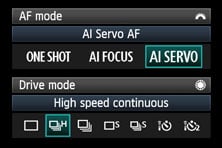 |
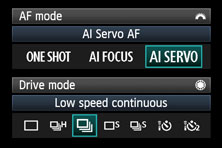 |
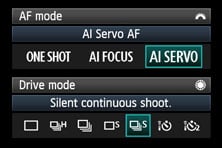 |
That’s the theory anyway. To put it into practice I performed a series of timings for bursts of JPEG and RAW files. I also repeated my tests with a CF card, an SD card, and both cards writing at the same time. The test conditions employed shooting in Shutter Priority mode with a speed of 1/800 at 400 ISO with Auto Lighting Optimiser disabled and focusing set to manual; I’ve discussed focus tracking for continuous bursts in the AF section earlier.
The Mark III claims to exploit the speed of UDMA-7 1000x Compact Flash cards, but won’t do the same for UHS-1 SD cards; you can use UHS-1 SD cards in the Mark III, but they won’t perform any quicker than non-UHS models. I didn’t have access to a UDMA 7 1000x Compact Flash card, so used the next quickest standard instead, a 16GB Lexar UDMA 6 card, rated at 600x; out of interest I also repeated some tests with a 300x card. For SD I used a 16GB SanDisk Extreme Pro UHS-1 card.
Starting with my UDMA-6 CF card, I fired-off 183 Large Fine JPEGs in 30.25 seconds, corresponding to a speed of 6.05fps; the camera seemed happy to continue firing at this speed and appeared to flush the buffer in real-time, with the write lamp remaining lit for less than a second after I let go of the shutter release.
I the switched to RAW and fired-off 18 frames in 2.81 seconds, corresponding to a speed of 6.4fps; beyond 18 frames, the shooting speed fell to around 3fps. Letting go of the shutter release after 18 frames took five seconds to flush the buffer. Switching to a 300x card reduced the total number of RAW frames to 15 and took eight seconds to finish writing after the burst, although the shooting speed during the burst remained 6.4fps.
Now it was time for the UHS-1 SD card. I aimed for a similar burst as before and fire-off 181 Large Fine JPEGs in 29.94 seconds, corresponding to a speed of 6.04fps. Once again the camera seemed happy to keep shooting, although revealingly, the 181 shot burst took eight seconds to completely flush compared to less than one with the UDMA-6 CF card.
Moving onto RAW, I fired-off 16 frames with the SD card in 2.52 seconds, corresponding to a rate of 6.34fps; this burst took 16 seconds to flush, compared to five seconds for a slightly larger 18 frame burst on the UDMA-6 CF card. Revealingly if I kept shooting beyond 16fps, the continuous speed fell to around 1fps, compared to around 3fps with the UDMA-6 card.
I also tried the Silent continuous shooting option, which worked out at a speed of 3.06fps for Large Fine JPEGs.
The Mark III also allows you to shoot with both cards simultaneously. I tried this first with both cards recording duplicate images for backup / redundancy purposes. This time I fired-off 141 Large Fine JPEGs before the rate slowed a little. The initial burst took 23.63 seconds, corresponding to a speed of 5.96fps and took a subsequent nine seconds to flush; clearly the write speed of the SD interface was holding back the CF card.
Next-up a burst of RAW, with 15 frames in 2.32 seconds, corresponding to a speed of 6.46fps before slowing to around 1fps, and with 17 seconds to flush the initial burst alone; again the SD interface slowing the potential speed of the UDMA-6 CF card.
I finally tried the option to record RAW files to the CF card and JPEGs to the SD card. I had high hopes for this mode, assuming the faster CF card could do the heavy-lifting of the RAW files, leaving the milder JPEG files to the slower SD interface. But I managed just eight frames in 1.2 seconds, corresponding to a speed of 6.66fps, after which the rate fell to 2fps.
Maybe it would work better the other way around, so I retested with RAW files being recorded to SD and JPEGs to CF, but this time managed a frame less with seven shots at around the same speed, after which the rate fell to less than 1fps.
The results are pretty clear: the Mark III delivers its best continuous shooting performance when fitted with a UDMA Compact Flash card, and it’ll slow down in some respects when fitted with even the fastest SD cards. Don’t blame this on the SD standard though: it’s because the Mark III sadly does not exploit the speed of UHS models.
The good news is when fitted with either type of card, the Mark III will deliver – or in the case of RAW files slightly exceed – the quoted speed of 6fps, making it a viable proposition for action photography. Where the card type really makes a real difference is in terms of flushing the buffer, with the quickest UDMA CF cards clearing it much faster than even the fastest SD cards. In the case of shooting RAW, this quicker flush speed will also see you achieve the maximum quoted number of frames per burst, whereas with SD you could miss out on a couple. I should also note that UDMA-6 (600x) CF cards flushed the buffer quicker than 300x cards, implying UDMA-7 cards at 1000x may do it even faster still. But the good news for anyone using UDMA-6 cards is they won’t hold back the maximum RAW burst size – I managed 18 frames, no problem.
In short, if you need to clear your buffer quickly, it’s best to use the fastest CF cards you can afford with the Mark III and to avoid SD. Of course you can’t avoid SD if you’re shooting with both cards simultaneously, in which case you’ll need to accept smaller bursts and leisurely buffer-flushing times. This won’t matter to some, but dedicated action shooters who like the idea of recording to two cards will want to take note.
I put the Mark III’s continuous shooting – and tracking autofocus – to the test in a variety of conditions, including photographing mountain bikes, jetboats, cars and kids running around. In each case the camera performed very confidently and really felt a world-apart from the earlier Mark II. Sure it doesn’t shoot at 8fps, 10fps or even faster speeds, but it is a viable camera for action photography, making it a much more rounded and versatile proposition than the Mark II – not to mention the D800 in this regard.
| Canon EOS 5D Mark III: Continuous Shooting with AF at 6fps | ||||||||
 |  |  |  |  | ||||
 |  |  |  |  | ||||
So how does the Nikon D800 actually compare? According to Nikon’s specs it’s slower, delivering 4fps for 36 Megapixel FX images, or 5fps for DX or 1.2x crop modes, the DX version boostable to 6fps with the battery grip (and right batteries). Interestingly like some earlier Nikon DSLRs, the manual states the maximum number of frames in any burst is 100, even if the resolution is lowered.
I matched the same conditions as the Mark III, setting the D800 to a shutter speed of 1/800, sensitivity of 400 ISO and disabling Active D-Lighting. Like the Mark III, the D800 claims to exploit the speed of UDMA-7 1000x Compact Flash cards, but unlike the Mark III, it should also exploit the speed of UHS-1 SD cards. I didn’t have access to a UDMA 7 1000x Compact Flash card, so used the next quickest standard instead, a 16GB Lexar UDMA 6 card, rated at 600x while for SD I used a 16GB SanDisk Extreme Pro UHS-1 card.
I started with the UDMA-6 CF card, which allowed me to capture a burst of exactly 100 Large Fine FX-format shots in 24.53 seconds, corresponding to a speed of 4.03fps; the manual quoted 100 shots and indeed the D800 stopped dead at this point, and took a considerable 66 seconds to flush the buffer to the card.
I then switched to Lossless-compressed 14-bit RAW and captured 19 FX shots in 4.46 seconds, corresponding to a rate of 4.26fps. This time the camera could continue firing afterwards, but at a reduced speed of just under 2fps. Letting go of the shutter at 19 frames took 14 seconds to flush the buffer.
I then decided to put the DX-format to the test which captures 16 Megapixel images from the middle of the sensor with a 1.5x field-reduction crop – essentially like using a D7000. Sticking with the UDMA-6 CF card I captured the quoted 100 Large Fine JPEGs in 19.59 seconds before stopping dead, corresponding to a speed of 5.1fps with a 62 second flush of the buffer. Switching to losslessy-compressed 14-bit RAW files in the DX format, I fired-off 40 frames in 7.78 seconds, corresponding to a rate of 5.14fps with a flush time of 33 seconds.
I then returned to the full FX frame size and switched the CF card for my UHS-1 SD card. I expected to capture 100 Large Fine JPEGs at the full speed, but was surprised to find the D800 stalling after 42 images in 10.25 seconds, corresponding to a speed of 4.09fps and with a buffer flush time of 44 seconds. Switching to losslessly-compressed 14-bit RAW files I captured 16 frames in 3.71 seconds, corresponding to a speed of 4.31fps with a buffer flush time of 25 seconds.
Like the Mark III the D800 can record to both cards at the same time, so I configured it to first duplicate the images on both the CF and SD cards. This time I could fire-off 31 Large Fine FX-format JPEGs at 4.16fps with a 27.24 second flush time. Switching to losslessly-compressed 14-bit RAW files saw 16 frames captured in 3.73 seconds or at 4.28fps with a 14 second flush time.
Next I configured the camera to record losslessly-compressed 14-bit RAW files to the CF card and Large Fine JPEGs to the SD card, both in the FX format. The D800 managed 16 frames in 3.82 seconds, or 4.18fps with a 17 second flush time. Switching the configuration so JPEGs were recorded to the CF card and RAW to the SD card allowed me to capture 15 frames at 4.33fps with a 14.68 second buffer flush.
Phew that was a lot of testing. Now let’s look at those figures. First things first: the D800 achieves its quoted speeds of 4fps in FX format and 5fps in DX format for JPEGs and slightly exceeding them in RAW. It also pretty much delivered the quoted buffer capacities, although I managed to squeeze a few more RAW files from the DX mode than the manual suggested. Either way when it came to JPEGs, 100 was the absolute maximum with the camera stopping dead at that figure as quoted.
4fps may be one third slower than the 6fps of the Canon 5D Mark III, but then the D800 is wrangling 50% more pixels in total. It’s nice to accelerate the D800 by cropping down to the DX mode, but this time you’re only getting 5fps despite a drop to 16 Megapixels – so in that respect it’s beaten on speed and resolution by the Mark III. And yes I know you can match the Mark III’s speed in DX mode, but you’ll need the optional battery grip with the right batteries and even then it’s still 6 Megapixels shy of the Mark III, not to mention using a cropped frame. So the D800 isn’t going to set the world of action and sports photography alight with those speeds, but 4fps can get you by in many situations and it remains impressive given the amount of data being handled.
In terms of the card formats, both UDMA-6 and UHS-1 cards could shoot at the same speed, but the former boasted larger bursts (especially so for JPEGs) and noticeably quicker flush times. So like the Canon Mark III, fast UDMA CF cards are preferable for the best continuous shooting performance.
As for comparing the card performance of the two cameras, the Canon 5D Mark III outshone the D800. Fitted with the same UDMA-6 card, the Mark III captured 183 Large Fine JPEGs at 6fps before I got bored and let go with a split second flush time compared to 100 shots on the D800 with an excruciating 66 second flush. Sure the D800 images were larger, but that’s a big difference in processing and write times. It’s also revealing to look at the UHS-1 performance, as while the Mark III claims not to exploit their extra speed, it did capture 181 frames (again until I got bored and let go) at 6fps with an eight second flush time compared to 42 images on the D800 with a 44 second flush time. Again the D800 was handling bigger images (typically twice the file size for JPEGs of the same scene when both were set to their best quality), but that still works out slower. Maybe it was the card interface, maybe the image processor, or some other factor at play. But the imaging pipeline as a whole on the D800 was slower.
So while some may have criticised the Mark III for not exploiting the speed of UHS-1 cards and paid respect to the D800 for supporting them, it’s important to look beyond the specs, perform some benchmarks and actually compare real numbers. And at that point, the Mark III begins to look even more respectable for action photography.
Canon EOS 5D Mark III sensor
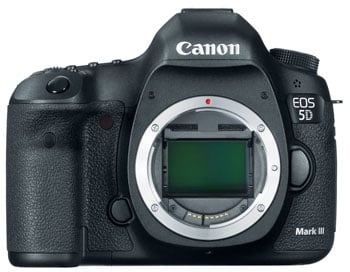 |
The EOS 5D Mark III is equipped with a new full-frame CMOS chip with 22.3 Megapixel resolution which delivers 3:2 shaped images with 5760×3840 pixels. That’s just over one more Megapixel than its predecessor which sported a 21.1 Megapixel sensor with images measuring 5616×3744 pixels.
Yep, you read that right, after a three and a half year gap you’re getting about 100 extra pixels in each axis which means the resolving power and maximum reproduction remains essentially the same. And lest we forget, this means it remains Canon’s highest resolution DSLR to date.
If you were hoping for a higher resolution Canon DSLR, you’ll understandably be disappointed. Indeed it’s a strikingly different strategy to Nikon which squeezes 36 Megapixels into its full-frame D800, delivering images with 7360×4912 pixels, while also offering a version without the anti-aliasing filter. Canon clearly believes it struck the sweet-spot for resolution and pixel-pitch with the EOS 5D Mark II and sees no reason to change it significantly just for the sake of playing the numbers game – and similarly no need for two versions either.
Take another look at the numbers though and you’ll see the 22.3 Megapixel figure hasn’t simply been plucked from the air. The image width of 5760 pixels is perfectly divisible by 1920, the width of HD video. This in turn makes it easier to down-sample the full sensor width to the HD frame while avoiding cropping and minimising scaling artefacts. Canon knew the 21.1 Megapixel resolution of the 5D Mark II was a sweet-spot for photo quality, so it simply adjusted the figure to the closest number which was easily divisible for HD video – and as seen in my samples in the Movie Mode section above, it really works too.
But there’s more to the EOS 5D Mark III’s new sensor than just a similar resolution to its predecessor. Canon’s implemented gapless micro-lenses and more efficient technology to improve the light-gathering power of each photosite, claiming lower noise, higher dynamic range and lower power consumption that the 5D Mark II. The company certainly feels sufficiently confident to boost the sensitivity range by two stops to 100-25,600 ISO, expandable to 50-102,400 ISO, and you can see how the quality looks in my Canon EOS 5D Mark III noise pages. Auto ISO can operate between 100 and 25600 ISO and you can set the minimum and maximum values, along with the slowest accompanying shutter speed from 1 second to 1/250.
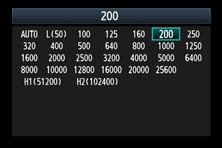 | 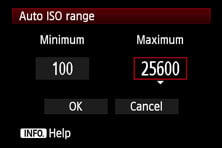 |
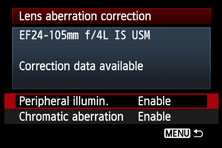 | 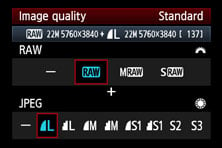 |
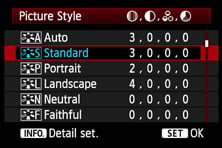 | 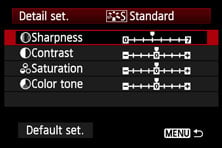 |
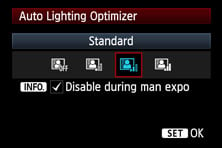 | 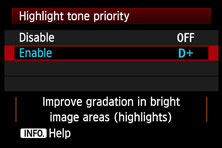 |
As (or even more) importantly, the 5D Mark III’s sensor features 8-channel readout and the much more powerful DIGIC-5+ processor behind the scenes, allowing it to pull data-off and crunch it faster than before. So as detailed earlier, the somewhat pedestrian 3.9fps continuous shooting speed of the Mark II enjoys an important boost to 6fps on the Mark III.
The DIGIC 5+ processor also offers some new tricks, so along with peripheral illumination correction, we now finally have chromatic aberration correction on a Canon DSLR. The Mark III also features a new dedicated ‘Rating’ button which lets you tag images with one to five stars in-camera, which can be imported with the images into Adobe and Apple management systems. It provides a fun way to start rating your photos in-camera in the field.
Images can be recorded as JPEG or 14 bit RAW files and you can of course record both if desired. JPEGs are available in five different resolutions with two compression options for the top three resolutions, while RAW files can be recorded in three different resolutions. It’s possible to set JPEG and RAW sizes separately, allowing you to record any combination.
As mentioned earlier the Mark III also sports twin card slots, one for Compact Flash, the other for SD. Canon claims the camera can exploit the speed of the latest UDMA-7 CF cards, but won’t exploit the speed of UHS-1 SD cards; you can still use UHS-1 cards, but they won’t got any quicker than normal quick SD cards. That said, as I discovered in the continuous shooting section above, the Mark III actually performs better with SD cards than the D800 which does claim to exploit UHS-1 cards.
Performance aside, you can configure the Mark III to record duplicate images on both cards for redundancy, record different types to each card (such as RAW to one and JPEG to the other), or simply switch from one to the other when the first fills up. While recording to two cards simultaneously will reduce performance to the lowest common denominator, it remains very useful for times when the event will not be repeated, such as weddings, political or sporting events. It’s very reassuring to know you have a backup in-camera, even if it’s simply to hand one card to a client while you keep the other.
As with earlier models, Sharpness, Contrast, Saturation and Colour Tone are set using Picture Styles with five presets, an Auto option and the ability to tweak any as desired and or store them in three custom slots. A Monochrome option switches the colour options for Filter and Toning effects.
I used the Standard Picture Style for all of my tests shots and found it delivered punchy-looking results which were on the whole very pleasing, although close inspection of very fine details sometimes revealing evidence of arguably over-zealous sharpening and contrast. So if you prefer a more natural look free of processing artefacts, you may want to dial-down the contrast and sharpness a little.
Like earlier models, the Mark III offers Auto Lighting Optimiser and Highlight Tone Priority to boost contrast and recover blown highlight areas respectively. As before Highlight Tone Priority operates at a minimum of 200 ISO and expands the dynamic range from standard 18% grey to bright highlights. Below are two shots taken of my standard outdoor test scene which contains saturated highlight areas in the roofing of many buildings towards the lower portion of the frame. In this particular example HTP has very subtly lowered the values of the bright highlights, something you can measure in Photoshop but which is hard to see below or even in the histograms for the entire image; that said, if you shoot a lot of bright highlights, such as under snowy conditions or of wedding dresses, HTP could provide useful protection against clipping.
Canon EOS 5D Mark III Aperture Priority mode (100% crop) | Canon EOS 5D Mark III Highlight Tone Priority (100% crop) | |
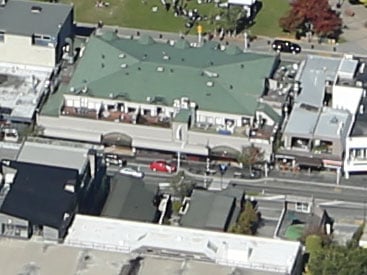 | 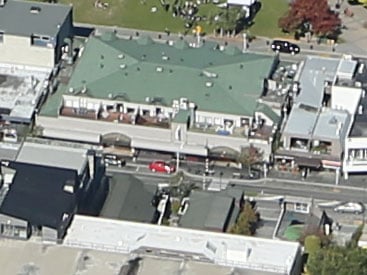 | |
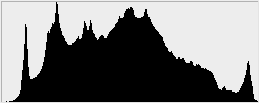 | 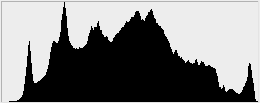 | |
1/800, f8, 200 ISO | 1/640, f8, 200 ISO | |
Now it’s time to see how the Mark III’s image quality measures-up. I’ve made a number of comparisons against the 5D Mark II, Nikon D800 and Sony NEX-7 over the following pages for both resolution and noise levels. At the time of writing though, a number of RAW converters either had not been updated for were exhibiting issues with Mark III and or D800 RAW files, so I’m leaving those comparisons until the dust settles and just comparing JPEGs for now. Don’t worry, I will update the review with RAW comparisons in the near future.
So in the meantime, take a look at my Canon 5D3 quality and Canon 5D3 noise results pages (noting I have many other results pages to view!), browse my Canon 5D3 sample images, or skip to the chase and head straight for my verdict.
